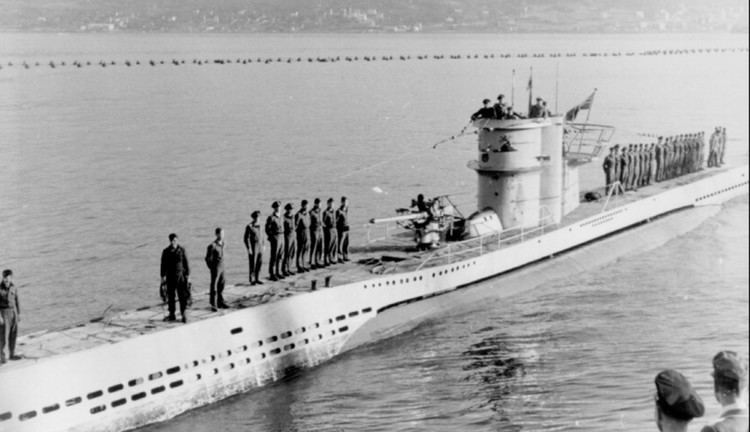Name U-963 Yard number 163 Commissioned 17 February 1943 Launched 30 December 1942 Draft 4.74 m Builder Blohm + Voss | Ordered 5 June 1941 Laid down 20 April 1942 Construction started 20 April 1942 Length 67 m Beam 6.18 m | |
 | ||
Fate Scuttled on 20 May 1945 | ||
German submarine U-963 was a Type VIIC U-boat of Nazi Germany's Kriegsmarine during World War II.
Contents
She was ordered on 5 June 1941, and was laid down on 20 April 1942 at Blohm & Voss, Hamburg, as yard number 163. She was launched on 30 December 1942 and commissioned under the command of Oberleutnant zur See Karl Boddenberg on 17 February 1943.
Design
German Type VIIC submarines were preceded by the shorter Type VIIB submarines. U-963 had a displacement of 769 tonnes (757 long tons) when at the surface and 871 tonnes (857 long tons) while submerged. She had a total length of 67.10 m (220 ft 2 in), a pressure hull length of 50.50 m (165 ft 8 in), a beam of 6.20 m (20 ft 4 in), a height of 9.60 m (31 ft 6 in), and a draught of 4.74 m (15 ft 7 in). The submarine was powered by two Germaniawerft F46 four-stroke, six-cylinder supercharged diesel engines producing a total of 2,800 to 3,200 metric horsepower (2,060 to 2,350 kW; 2,760 to 3,160 shp) for use while surfaced, two Garbe, Lahmeyer & Co. RP 137/c double-acting electric motors producing a total of 750 metric horsepower (550 kW; 740 shp) for use while submerged. She had two shafts and two 1.23 m (4 ft) propellers. The boat was capable of operating at depths of up to 230 metres (750 ft).
The submarine had a maximum surface speed of 17.7 knots (32.8 km/h; 20.4 mph) and a maximum submerged speed of 7.6 knots (14.1 km/h; 8.7 mph). When submerged, the boat could operate for 80 nautical miles (150 km; 92 mi) at 4 knots (7.4 km/h; 4.6 mph); when surfaced, she could travel 8,500 nautical miles (15,700 km; 9,800 mi) at 10 knots (19 km/h; 12 mph). U-963 was fitted with five 53.3 cm (21 in) torpedo tubes (four fitted at the bow and one at the stern), fourteen torpedoes or 26 TMA mines, one 8.8 cm (3.46 in) SK C/35 naval gun, 220 rounds, and an anti-aircraft gun. The boat had a complement of between 44 — 52 men.
Service history
U-963 had a recorded five attacks on her. The first two during her fourth war patrol. On 5 February 1944, when she shot down a British B-24 Liberator of 53 Squadron/T RAF. Then on 26 March 1944, off of Brest, France, she came under attack by an unidentified Allied airplane. This attack left nine men wounded, with two of them being badly injured. U-963 docked at Brest the next day.
Shortly after U-963 left Brest on 7 June 1944, on her fifth war patrol, she came under attack by another British B-24 of 53 Squadron RAF, piloted by John William Carmichael. The bomber was able to damage U-963 so severely that she had to return to Brest less than 24 hours after leaving for her patrol.
On 12 August 1944, the submarine base in Brest was bombed, killing one man during the air raid and so severely wounding another that he died the next day.
The last attack came on 21 August 1944, in the Bay of Biscay. Just after midnight U-963 was forced into a crash dive and one man was lost overboard.
On 20 May 1945, the crew of U-963 scuttled her off of Nazaré, Portugal. The entire crew survived.
The wreck is located at 39°36′N 09°05′W.
Wolfpacks
U-921 took part in eight wolfpacks, namely.
